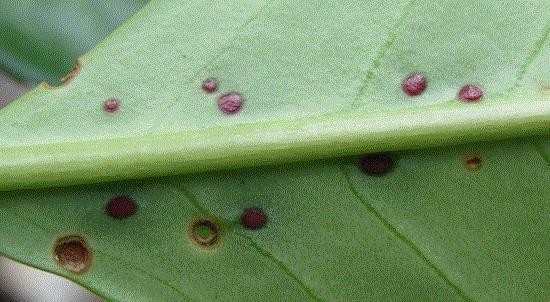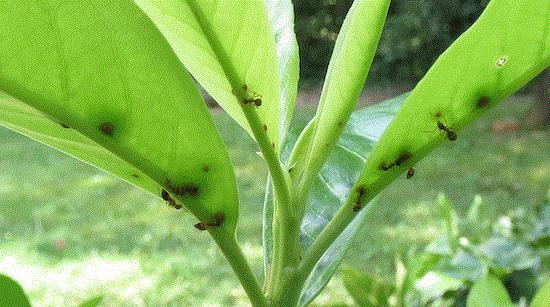What the ... ?
I made a friend through this newsletter recently.
Virginia White, who is a reader of this newsletter, contacted me in June about identifying a sawfly on her Philadelphus. I totally bombed that one and had to refer her to the real experts. Sure enough, there was a tentative identification soon after her submission to the experts. That, apparently, was a newly-described, really rare and special sawfly species.
Not offended by my ineptitude, Virginia sent me another quiz last week and wondered if she had some kind of scale insects on her Prunus laurocerasus.

What are these brown, raised spots on the underside of the leaves of cherry laurel? (Photo courtesy of Virginia White)
And redeem myself I did! Those brown spots on the leaves are actually extra-floral nectaries. For those who are not familiar with extra-floral nectaries, they are glands produced by some plant species on their stems, leaves, petioles, bracts, fruits, etc. that secrete a small amount of sugary solution or nectar. The nectar produced by extra-floral nectaries is different in composition to the nectar produced by flowers and it may not be available at all times.
What are the functions of extra-floral nectaries? There are two hypotheses. The first hypothesis suggests that the organ is nothing more than an excretory organ to rid the plant of metabolic waste. I don't know about this hypothesis. Seems a bit anticlimactic, and for plants, carbohydrates are certainly not waste.
The second hypothesis is the favorite of most ecologists. It identifies extra-floral nectar as a product purposefully produced to attract insects. Similar to how nectar in flowers attracts pollinators, nectar from extra-floral nectaries attracts insects that can help protect the plants—for example, those ants on Virginia’s cherry laurel. When the ants, wasps, ladybeetles or predatory flies are attracted to the extra-floral nectaries, they stay around the same plant and may feed on pests (such as aphids) that are present on the plant. You can think of the relationship as the plants paying for protective services with sugar.

Extra-floral nectaries produce nectar to attract insects, such as ants, that would serve as protectors. (Photo courtesy of Virginia White)
That was pretty awesome. Thanks for sharing your bug and plant pictures, Virginia. I look forward to more.
And, for everyone out there: Will you be my friend, and send me pictures of bugs and cruds?

Pest management on poinsettia cuttings
It is poinsettia season. Whether you’ll stick unrooted cuttings or plant rooted cuttings, I’ll take this opportunity to talk about a few insect and disease problems you may come across during the propagation phase. Most of the insect and disease problems wreaking havoc during the propagation phase are associated with the fact that the cuttings are grown in wet environment.
When you are rooting cuttings in wet medium and in a hot greenhouse, you’ll have to watch out for root rots—pythium, rhizoctonia and erwinia are the major root and stem rot diseases of poinsettia cuttings.
Erwinia causes bacterial blight and cutting rot in poinsettia. This bacterium invades the cut wounds and multiplies quickly in high moisture and high temperature. The plant tissues seem to just completely disintegrate into a watery, mushy mess. The infected cuttings cannot take up water and nutrients, so they just wilt and die. These dead plants should be removed from the propagation area immediately because the dead plants can release millions of bacteria into the area and the bacteria can be dispersed by constant misting.
Rhizoctonia is the most common fungal root and stem rot disease of poinsettia cuttings. The fungal spores are often splashed from infected plant debris and soil by irrigation water. Lesions caused by the fungi usually develop at the soil line, and quickly spread around the stem and eventually girdle it. Leaves touching the medium can also be infected. Light infection during the propagation phase may become stem and crown rots later in the production cycle.
Pythium usually raises its ugly head later in the cutting propagation or soon after transplant to the pots. Pythium invades the roots, particularly those that are stressed by pronounced periods of dry and wet and high salinity (or fertility, since fertilizers are basically salts). Infected plants appear wilted but do not respond to irrigation because the infected roots have disintegrated.
The management of bacterial and fungal stem and root rots begins with a clean propagation area. Most of these pathogens spread from infected plant debris, old medium and exposed soil; therefore, the propagation area should be clean of these sources. Water used in the misting system should also be clean, and when necessary (such as when sourced from surface water) the water should be treated before use. Maintaining a clean propagation area and receiving only indexed cuttings are the only methods effective in reducing erwinia infection because copper products are not effective against this disease during propagation. Preventive treatment for pythium and rhizoctonia can be conducted through a drench of biological control agents (such as Trichoderma spp.) or fungicides (such as cyazofamid, etridiazole, mefenoxam and pyraclostrobin for pythium, and cyprodinil, fludioxonil, pyraclostrobin and thiophanate methyl for rhizoctonia).
The biggest insect problem of poinsettia cuttings is the fungus gnat. Shore flies can also appear but their damage to poinsettia cuttings is nowhere near that of the fungus gnat. Fungus gnats love wet medium, and y’all can often find adults “dancing” on the rim of the pots or trays. Adults are not a problem, but their larvae can nibble on the roots and stems of cuttings, creating wounds that allow invasion of pathogens such as rhizoctonia and pythium.
Moisture control is the most important step in fungus gnat management. Larvae could be managed with a drench or sprench of neonicotinoids (acetamiprid, dinotefuran, imidacloprid and thiamethoxam), insect growth regulators (s-kinoprene, pyriproxyfen and cyromazine), chlorfenapyr, azadirachtin, and insect pathogens (Steinernema feltiae, Beauveria bassiana, Isaria fumosorosea and Bacillus thuringiensis subsp. israelensis).When needed, adult fungus gnat populations can be knocked down with spray applications of an organophosphate or pyrethroid.
Managing your pest problems well will help reduce shrink during the propagation phase.
Pest management on cuttings is also an important way to combat pest problems that show up later in the growing phase, particularly whiteflies, thrips and spider mites.
A team led by Rose Buitenhuis and Michael Brownbridge conducted a series of studies investigating the potential of a “clean start” program by dipping unrooted poinsettia cuttings in solutions of oil, soap and/or insect pathogens to reduce the population of whiteflies.Dipping cuttings in 0.5% insecticidal soap and Beauveria bassiana (BotaniGard at label rate) before sticking can reduce the whitefly population by 70% while not increasing the risk of erwinia infection. Better yet, a biological control program on plants grown from dipped cuttings was more effective because the initial whitefly population was reduced by the dip, thus allowing the natural enemies a better chance of succeeding. In a separate study, dipping chrysanthemum cuttings in a 0.5% oil solution also reduced thrips populations.
I hope this issue of PestTalks has armed you with information to have a successful and relatively pest-free poinsettia propagation. We’ll talk about the pests of poinsettia during its growing phase next time.

Pest management presentations at the Farwest Show
Are you going to the Farwest Show this year? If you haven't put that event on the calendar, here are the dates: August 22-24. Nursery Tours are scheduled for August 21. Click on the Farwest Show banner ad in this newsletter for more information.
I saw several pest management presentations on the schedule that I thought might be of interest to y’all.
The first one is to be presented by Kelly Vance of Beneficial Insectary. Kelly’s presentation, titled “Not All Mites Are Spider Mites: Bio Control ofBbroad, Russet and Cyclamen Mites,” is scheduled for Wednesday, August 22, 8:30–9:30 a.m. Kelly will talk about biology, inspection, quarantine, and biological control of mites, with focus on the “micro-mites”—broad, cyclamen and russet mites.
After Kelly’s talk, you can stay in the same room for Andony Melathopoulos’s talk, “'Bees' A Four Letter Word, Or An Opportunity For Landscapers and Nurseries?” Andony is the pollinator health extension specialist at Oregon State University. He will talk about practical steps to use pesticides safely around pollinators and how to make pollinator concerns into a potential marketing opportunity.
My friend Robin Rosetta of Oregon State University will give a talk on “The Aim Game: Intelligent Spray System Technology For Nurseries” on Thursday, August 23, 9:45–10:45 a.m. Robin has worked with a team of researchers to develop an intelligent sprayer that can greatly reduce spray volume (think 50%) while achieving the same control. Robin will update us on this game-changing technology that she has been working on for the past eight years.
On Friday, August 24, 8:30–9:30 a.m., go to Jill Calabro’s talk on “What You Need To Know About Boxwood Blight.” Jill is the Director of Science and Research Programs at AmericanHort, and she will be talking about Horticultural Research Institute’s (HRI) efforts and results on the boxwood blight initiative.
Stay in the same room for Moriah LaChapell’s talk on “Practical Applications of Biological Control Agents.” Moriah will discuss different types of biological control agents and biopesticides, and the compatibility of pesticides with biological control agents.
Have fun if you are going to Portland!






See y'all next time!

JC Chong
Associate Professor of Entomology at Clemson University
This e-mail received by 24,620 subscribers like you!
If you're interested in advertising on PestTalks contact Kim Brown ASAP!